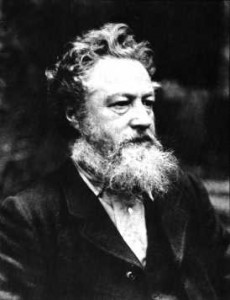As the year winds up, I thought I’d write about another aspect of what we’re trying to do at Holton Studio—about our greater mission and purpose as a business. Because with the economy in a shambles, I believe it’s time businesses think in a fundamentally new way—which is actually an old way, as you’ll see—about what business is for.
Is the purpose of a business to make money? In answer to the commonplace belief that it is, John Ruskin wrote:
The fact is, that people never have had clearly explained to them the true functions of a merchant with respect to other people…
Five great intellectual professions, relating to daily necessities of life, have hitherto existed—three exist necessarily, in every civilized nation:
The Soldier’s profession is to defend it.
The Pastor’s, to teach it.
The Physician’s, to keep it in health.
The Lawyer’s, to enforce justice in it.
The Merchant’s, to provide for it.…[T]he merchant’s function (or manufacturer’s, for in the broad sense in which it is here used the word must be understood to include both) is to provide for the nation. It is no more his function to get profit for himself out of that provision than it is a clergyman’s function to get his stipend. The stipend is a due and necessary adjunct, but not the object, of his life, if he be a true clergyman, any more than his fee (or honorarium) is the object of life to a true physician. Neither is his fee the object of life to a true merchant.
Who but a hopeless romantic—like John Ruskin, many will say—would expect serious business people to follow such an ideal? Well, for you scrooges out there, here’s one example from today’s New York Times—a banker, no less, in the small upstate NY town of Cattaraugus. The 130-year old Bank of Cattaraugus, the story says, “operates according to an antiquated theory of the business: that a bank should be a utility, like the power company, and serve as a broker between savers and borrowers in its community.”
While “banks have been dying for 20 years,” according to The Times, we’re witnessing a change as hard experience is reminding us of a bank’s true purpose which should be to provide for the savings and credit needs of a community. And smaller banks that have operated with that understanding are finally being appreciated. “In the last year…anger over big banks’ fees and mortgage lending practices has turned consumers against the mega-banks, and smaller institutions have been the beneficiaries.”
But what about growth—another widely assumed purpose of business? Bank president Patrick J. Cullen has faced that question many times.
“My examiners always ask me, ‘When are you going to grow?’ …But where is it written I have to grow? We take care of our customers.”
Pretty refreshing, no? But where’s the incentive? In partaking in, and facilitating, the life, joys and satisfactions of a genuine community—and, as Ruskin said, of “every civilized nation.”
There is, after all, in that sage’s famous words, no wealth but life.
Merry Christmas!

